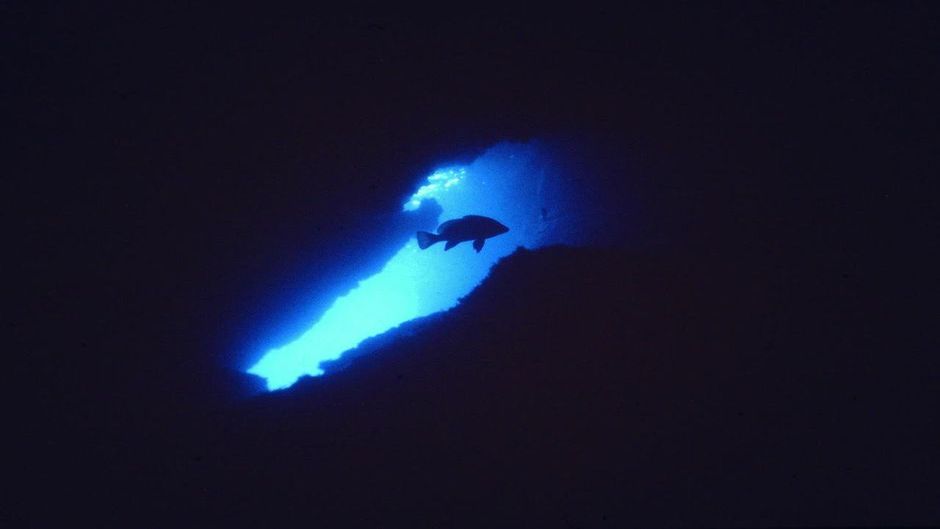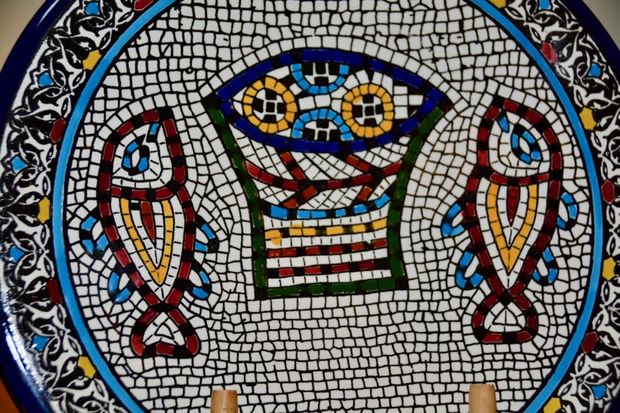During the second century, believers identified themselves to each other by drawing the simple figure of a fish on the ground or on the walls of the catacombs in Rome.
 Photo: Antonio Cruz.
Photo: Antonio Cruz.
Then God said, “Let us make man[a] in our image,
after our likeness. And let them have dominion
over the fish of the sea and over the birds of the heavens
and over the livestock and over all the earth and
over every creeping thing that creeps on the earth.” (Genesis 1:26)
However, not to give offense to them,
go to the sea and cast a hook and take
the first fish that comes up, and when you open its mouth
you will find a shekel.
Take that and give it to them for me and for yourself.” (Mt. 17:27)
In Hebrew, the term for “fish” is dag, a term which literally means “to twist”. It was translated into Greek as ikhthýs, which also means “fish”, or ikhthydion, the diminutive form translated as “little fish” in the New Testament (Matt. 15:34; Mark 8:7).
There is also another Greek term which denotes large marine animals like whales or dolphins. This term is ketos, from which we get the term cetacean.
This is precisely the word used for the large fish in the book of Jonah (Genesis 1:21; Job 3:8; 9:13; 26:12; Jonah 1:17; 2:1,10), as it can correspond either to the Hebrew term dag, or to the term tannin, which means marine monster (Gen. 1:21; Job 7:12; Psalm 74:13; 148:7).
Although fish are mentioned more than forty times in the Bible, there are no references to any specific species. Solomon is known to have been an expert in flora and fauna, and frequently held forth about animals and fish (1 Kings 4:33), so it is curious that there is such a lack of specific information about or interest in aquatic life, especially bearing in mind that the livelihoods of the villages on the shores of lake Galilee, the Mediterranean and the Red Sea were based on fishing.
Besides, the river Nile abounded in fish, which the Hebrews ate while they were in Egypt and which they later hankered for during their desert wanderings (Numbers 11:5).
This disinterest might have been due to the belief on the part of the Hebrews that the sea was a dangerous place, inhabited by monsters and maleficent creatures. Contact with other peoples, such as the Philistines, who believed, for example, that the mythical god Dagon, half fish and half man, might have influenced Hebrew aversion to the oceans, the marine abyss and the creatures that lived there (Psalm 104:25-26; 107:23-27) etc.
Despite everything, the Hebrews classified fish in terms of whether or not they could be eaten. The law of Moses clearly stipulated that the sea and freshwater creatures that were kosher were those that “had fins and scales” (Lev. 11:9).
Hence, at the time of Jesus, the fishermen on the Sea of Galilee divided the contents of their nets into good fish, which they put in baskets, and bad fish, which they threw back into the water (Matt. 13:48).
Not much needs to be said about the fish that the Hebrews caught on the Mediterranean coast, as they are native to these waters and are widely known: bream, bass, red mullet, carp, cow bream, grouper, scorpion fish and many other types that habitually ended up in their nets.
As regards the fish in the Nile which they were familiar with while in Egypt, many of them were also a staple food source, both for the many species of of waterfowl and for humans.
The Hebrews did not eat fish without scales, such as catfish, as they were considered unclean by the terms of the Levitical laws, but they did eat perch, carp, barbel, tilapia and other cyprinids.
The fresh water of lake Gennesaret, or the Sea of Galilee, has been famous since ancient times for its variety of fish. It is 21 km long, from north to south, by 12 km wide, from east to west, with a depth of 48 metres and a surface area of 166 square km.
It is situated at 212 m below the level of the Mediterranean, which makes it the lowest-level freshwater lake in the world. Among the many species living there now, at least 18 are autochthonous, that is to say, that they can only be found in this lake. There are others from other places that have been introduced by humans.
There are damsel fish (Pomacentridae), blenoid fish (Blennioidei), catfish (Clarias macranthus) measuring almost a metre in length, barbel fish, tilapia, freshwater sardines, and so on.
The 19th century English naturalist H.B Tristram, who was well-acquainted with the Holy Land, listed 22 species of fish native to the Sea of Galilee, but said he was certain that there were many more.
In his “Natural History of the Bible” he identifies two species of fish belonging to the Blenniidae family, seven of the Chromidae family, one of the Siluridae family and twelve of the Cyprinidae family. [1] Several species exclusive to this stretch of fresh water were given names deriving from biblical characters, such as the Chromis andreae, Chromis simonis, Chromis magdalenae and Chromis tiberiadis.
As regards the latter species, enormous shoals of up to 4 kilometres have been identified. Most of these species can also be found in the Jordan river and in its many tributaries.
There is an endemic species that is very similar to saltwater sardines, popularly known as the “Galilee Sardine” (Acanthobrama terraesanctae), belonging to the Cyprinidae family, which could reach lengths of up to 25 cm. [2]
Some scholars believe that this is the species referred to in the stories of the multiplication of the loaves and fish (Mt. 14:17; Mk. 6:38; Lk. 9:13; Jn. 6:9). In fact, tonnes of this type of fish continue to be caught in lake Galilee every night. They are canned, and still form part of the staple diet of the Israeli people.
Another famous species from the Sea of Galilee is the Sarotherodon galileus, a cichlid fish popularly known as “St Peter’s fish” (not to be confused with another St Peter’s fish, namely the Zeus faber from the Mediterranean).
Its dorsal fin is very long and is reminiscent of a comb. It can reach a length of 40 cm and a weight of approximately 1.5 kg. It is served fried, with potatoes, to tourists in restaurants on the shores of Lake Tiberias, and has thus become a typical dish from the region.
It is often said that it was in the mouth of this fish, caught by Peter, that the coin was found which served to pay the temple tax, as Jesus instructed (Mt 17:24-27).
However, this fish usually feeds on microscopic plankton and will not ingest any other kind of food, especially if used to bait a hook. Some Galilee fishermen believe that the barbel (Barbus longiceps) might have been the fish in question, as even today it is still fished with a hook and sardine-bait.
This fish, which has a large mouth and can reach a length of 1.5 metres, is native to the river Jordan and the Sea of Galilee.
The Semitic peoples also had a great deal of contact with the fish of the Red Sea, via the Gulf of Eilat or Akaba, and they knew from ancient times that the species there were very different from those of the Mediterranean, and, needless to say, from the freshwater species of the Sea of Galilee or the river Nile.
In these warmer waters there are approximately 1,200 different species of fish, particularly noteworthy of which are the whitetip sharks. These fish are generally brightly coloured and move with great agility among the more than 400 species of corals in the benthos.
10% of the fish in the Red Sea are exclusive to this particular ecosystem, and cannot be found in any other sea in the world. Currently, certain invasive species have found their way into the Mediterranean through the Suez Canal, and have begun to endanger the ecosystems of this formerly enclosed sea.
The Christians of the first centuries of the Church used the symbol of the fish as an acrostic of the Lord Jesus. The letters that make up the Greek word for fish (IKHTHYS, ΙΧΘΥΣ) could be made to stand for the titles ascribed to Christ: Ἰησοῦς Χριστός Θεοῦ Υἱός Σωτήρ, Iesûs Khristós Theû Huiós Soter, meaning Jesus Christ Son of God, Saviour.

This phrase, which sums up the identity and mission of Christ, probably originated in Alexandria as a kind of rebel protest against the persecution and tyranny instigated by the emperors who wanted their subjects to attribute divinity to them.
During the second century, believers would identify themselves to each other by drawing the simple figure of a fish on the ground (piscis in Latin) or on the walls of the catacombs in Rome.
They were aware of their similarity to fish in that they, like fish, were “born” out of the water of baptism. It was for that reason that baptistries came to be known as “piscinas”. This symbol of the fish ceased to be used after the death of Constantine.
In the Catholic Church of the multiplication of the Loaves and the Fish in Tabgha, near Capernaum, there is a famous mosaic dating from the end of 5th century AD, or the beginning of the 6th century, which depicts a basket of loaves surrounded by two large fish.
According to tradition, this was where this famous miracle took place. However, the two fish in the mosaic do not appear to be from the Sea of Galilee, on whose shores the church, which is still visited by thousands of tourists, stands.
The problem is that all the fish that are native to this huge lake have a single dorsal fin, while the ones depicted in the mosaic have two.
Archaeologists believe that the artist responsible for the mosaic may well have been a foreigner and based his depiction on fish from other places, not from the Sea of Galilee.
Can fish that live in water suffer from thirst? The answer is that they can. Fish need fresh water, just like land animals. The problem for saltwater fish is that the water they swim in has a higher concentration of salt than the water in their body cells.
This could kill them, due to the law of osmosis (the water leaving the cells of the fish’s body tends to have a lower concentration of salt than the surrounding seawater). However, the Creator arranged for the excess salt absorbed by the fish to be eliminated through the gills and the urinary tract.
The attitude of some people is reminiscent of certain fish. Despite being immersed in so much evidence for an intelligent Creator they prefer to “go thirsty”, and refuse to accept his existence or acknowledge him as Creator.
However, the Lord Jesus continues to say to them: Come to me all you who are weary and heavy-laden, and I will give you rest (Mt 11:28).
[1] Tristram, H. B. 1883, The Natural History of the Bible, London, p. 282-294.
[2] Nelson, J., 1994, Fishes of the World, 3a., ed. John Wiley and Sons, New York, USA.

Las opiniones vertidas por nuestros colaboradores se realizan a nivel personal, pudiendo coincidir o no con la postura de la dirección de Protestante Digital.
Si quieres comentar o